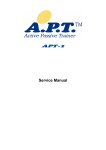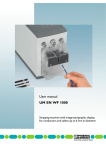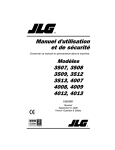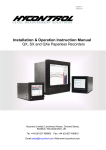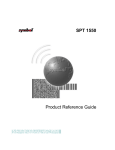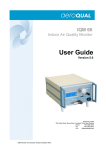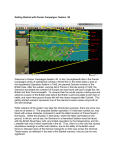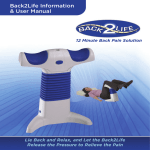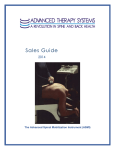Download the APT-5 Users Manual in PDF Format
Transcript
APTAPT-5 USER’S MANUAL APT-5 – User’s Manual Rev. 0502 2 Table of contents: Page 1. Introduction 5 2. System components 6 3. Preparing the APT-5 Hi-Lo 9 4. Installation for use – Arms exercise 10 5. Installation for use - Legs exercise 12 6. Operation instructions 14 7. General Maintenance & Storage 19 8. Trouble shooting 20 9. Accessories 21 10. Technical Data 22 NOTE: Design details may change without notice APT-5 – User’s Manual Rev. 0502 3 APT-5 – User’s Manual Rev. 0502 4 1. INTRODUCTION The APT-5 is an electric exercise machine used for the improvement of physical abilities. The APT-5 provides the user with a variety of exercise options and modes of operation that meet a broad range of physical needs. A wide range of accessories are available that offer many exercise options and make the APT-5 suitable for the maintenance of fitness and physical well being. The APT-5 can be operated in either the ACTIVE mode at varying degrees of resistance or in the PASSIVE mode at adjustable speed and torque levels. In the PASSIVE mode it is also possible to combine PASSIVE with ACTIVE training by using physical effort in conjunction with the electrical operation of the motor. The APT-5 functions forwards or backwards and is suitable for arm or leg exercises (upper or lower limbs). In case the user has limited strength in the arm, it is recommended to have an attendant present during exercise. The APT-5’s light weight makes it portable, easy to store and convenient to use in the comfort of one’s home. The unit is also suitable for use in healthcare institutions. Use of the APT-5 is recommended for the maintenance of muscle strength, flexibility, muscle tone, endurance and general fitness for users of all ages. APT-5 – User’s Manual Rev. 0502 5 2. SYSTEM COMPONENTS AND DETAILS 2.1. APT-5 unit (Figure 1) 1. Operator panel 2. Angle release knob 3. Angle securing knob 4. Crank-arm 5. Power input socket 6. Heart Rate receiver input socket 7. Height release knob (Hi-Lo only) 8. Height securing knob (Hi-Lo only) 2.2. 1. 2. 3. 4. 5. Primary components (Figure 2): Power supply unit Straight hand-grips Footrests Finger protection disks Securing straps APT-5 – User’s Manual Rev. 0502 6 2.3. The APT-5 - Operator Panel 1 On/Off button: green indicator is lit when the APT-5 is switched on. 2 Mode button: for selecting active or passive mode of operation. 3 Green indicator is lit when ACTIVE mode is selected by mode button. 4 Green indicator is lit when PASSIVE mode is selected by mode button. 5 10% 25% 50% APT-5 – User’s Manual 75% 100% Indicates actual load level as percentage of chosen load level (see 16). Rev. 0502 7 6 7 Button for forward operation in the PASSIVE mode. The green indicator is lit to indicate forward operation. Button for backward operation in the PASSIVE mode. The green indicator is lit to indicate backward operation. 8 Button activating Auto-Reverse function in the PASSIVE mode. In the ACTIVE mode this button activates the constant force function. The green indicator is lit when activated. 9 Button for selecting display of data, (see 1013): 10 Green indicator is lit when Timer display is selected. The display will show the time the APT-5 has been used in the current exercise period. 11 Green indicator is lit when Counter display is selected. The display will show the total amount of revolutions of the crank arm in the current exercise period. 12 Green indicator is lit when Power display is selected. The display will show the power during exercise in Watts – only in Active mode. 13 Green indicator is lit when heart rate display is selected. The display will show the current heart rate per minute – only when the Heart Rate receiver is plugged in. 14 Display for Timer, Counter, Energy and Heart Rate. 15 Exercise speed level selection push buttons 15a – Increases speed level (up to 10) 15b – Decreases speed level (down to 1) 16 Exercise load level selection push buttons 16a – Increases load level (up to 10) 16b – Decreases load level (down to 1) APT-5 – User’s Manual Rev. 0502 8 3. PREPARING THE APT-5 HI-LO 3.1. Moving your APT-5 Hi-Lo The APT-5 Hi-Lo can easily be moved by lifting the end of the frame and pushing the unit using its wheels, see Figure 4. 3.2. Positioning the APT-5 Hi-Lo Position the APT-5 Hi-Lo close to an electrical socket outlet. The adjustable feet on the underside keep the APT-5 Hi-Lo level and prevent it from sliding. NOTE: Ensure that the APT-5 Hi-Lo is level in order to prevent damage to the trainer or its components. If readjustment of one of the feet is needed, open the contra nut (4A/1), turn the foot (4A/2) to the desired height and secure the foot with the contra nut (4A/1). APT-5 – User’s Manual Rev. 0502 9 4. INSTALLATION FOR USE – ARMS EXERCISE Step 1: Position the APT-5 on a level table top close to an electrical socket outlet (Figure 5). For the APT-5 Hi-Lo: loosen the height securing knob (Figure 1A-8), pull the grey ring of the height release knob (Figure 1A-7) and adjust the unit to the required height. Release the grey ring and tighten the height securing knob (Figure 1A-7). Step 2: Loosen the angle-securing knob (Figure 5-1) and adjust the APT5 to the required angle. To increase the angle, lift the body of the APT-5, allow it to “click” into one of the operating positions and retighten the securing knob. To decrease the angle, pull the angle release knob (Figure 6), lower the body of the APT-5, allow it to “click” into another operating position and tighten the securing knob. CAUTION: Make sure that the minimum distance between crank arm and the table surface is approximately 5 cm. / 2” (Figure 5-2). Step 3: Connect the output connector (Figure 7-1) of the power supply (Figure 7-4) to the APT-5 power input socket (Figure 7-2a) while ensuring correct position of connector groove opposite the guide key of socket (Figure 7-2b). NOTE: The APT-5 must be used only with an original APT-5 Power Supply unit. APT-5 – User’s Manual Rev. 0502 10 Step 4: Install the finger protection discs (Fig. 8-1) by sliding them into the grooves on the outside edges of the crank arms (Figure 8-2) in the direction shown. NOTE: The finger protection discs are important for safe operation of the unit during hands exercise. Step 5: Insert handgrip (Figure 9-1) in one of the four mounting holes (Figure 9-2) in each of the APT-5 crank arms. Installation or removal requires only a straight push or pull while simultaneously pressing on the release pin (Figure 9-3) at the end of the handle. NOTE: The choice of mounting hole provides variable resistance levels and ranges of motion. See operation instructions. 3 Step 6: Plug the power supply mains power plug into the electrical socket outlet (Figure 5-3). To start operating, press the button. The APT-5 will enter the stand-by position. Then press the button. The green ACTIVE mode indicator will light up. You may start exercising in the ACTIVE mode. For operation instructions, see 5.1 & 5.2. NOTE: If the APT-5 moves across the table during arm exercises, anti-slip pads (Figure 8-3) may require cleaning. APT-5 – User’s Manual Rev. 0502 11 5. INSTALLATION FOR USE – LEG EXERCISE Step 1: Position the APT-5 on the floor close to an electrical socket outlet (Figure 10). Step 2: Loosen the angle-securing knob (Figure 10-1) and adjust the APT-5 to the required angle. To increase the angle, lift the body of the APT-5, allow it to “click” into one of the operating positions and retighten the securing knob. To decrease the angle, pull the angle release knob (Figure 11), lower the body of the APT-5, allow it to “click” into another operating position and tighten the securing knob. CAUTION: Make sure that the minimum distance between crank arm and the floor surface is approximately 5 cm. / 2” (Figure 10-2) Step 3: Place a chair at the desired distance from the APT-5. If necessary, attach the Securing straps (Figure 10-6) between the APT-5 base rings (Figure 10-5) and the chair legs to prevent any change in distance between the APT-5 and the chair during leg exercises. APT-5 – User’s Manual Rev. 0502 12 Step 4: Connect the power output connector (Figure 12-1) of the power supply (Figure 12-4) to the APT-5 power input socket (Figure 122a) while ensuring correct position of connector groove opposite the guide key of socket (Figure 12-2b). NOTE: The APT-5 must be used only with an original APT-5 Power Supply unit. Step 5: Insert Footrest (Figure 13-1) in one of the four mounting holes (Figure 13-2) in each of the APT-5 crank arms. Installation or removal requires only a straight push or pull while simultaneously pressing on the release pin (Figure 13-3) as shown. Secure feet in place with straps fastened diagonally as shown in Figure 10. NOTE: The choice of mounting hole provides variable resistance levels and ranges of motion. See operation instructions. Step 6: Plug the power supply mains power plug into the electrical socket outlet (Figure 10-3). The APT-5 will enter a stand-by position. To start operating, press the button. The APT-5 will enter the stand-by position. Then press the button. The green ACTIVE mode indicator will light up. You may start exercising in the ACTIVE mode. For operation instructions, see 5.1 & 5.2. NOTE: If the APT-5 moves across the floor during leg exercises, anti-slip pads (Figure 8-3) may require cleaning. If possible – use the APT-5 on a carpet or rubber mat. APT-5 – User’s Manual Rev. 0502 13 6. OPERATION INSTRUCTIONS NOTE: Install APT-5 for arms or legs exercise as described in the previous chapters. 6.1. Active mode - ISOKINETIC operation Step 1: Insert the handgrips or footrests in one of the four mounting holes according to the radius and range of motion required. NOTE: As the effective crank arm length is reduced in the ACTIVE mode, the amount of effort required increases while the range of motion decreases, and vice versa. Step 2: To activate the active mode from the stand-by position (after the electrical power is supplied to the APT-5 and the button is pressed): press the TIVE mode indicator will light up. button. The green AC- Step 3: Set the desired load level by pressing one of the selection push buttons, crease the level. to increase the level or to de- Step 4: Rotate the APT-5 handgrips or footrests forward or backward. Actual exercising force is displayed as a percentage (%) on the Bar Indicator. NOTE: In this mode, an increase in the rotation speed (RPM) will lead to an increase in the exercising force. 6.2. Active mode - CONSTANT FORCE Operation Step 1: Press the button to activate the CONSTANT FORCE FUNCTION in the ACTIVE mode. The green indicator will light up. Step 2: Set the desired load level by pressing one of the selection push buttons, crease the level. to increase the level or to de- Step 3: Rotate the APT-5 handgrips or footrests forward or backwards. The exercising force as displayed on the Bar Indicator will now remain constant at 50% for the selected load level, irrespective of the crank arm rotation speed. APT-5 – User’s Manual Rev. 0502 14 6.3. PASSIVE mode Step 1: Insert the handgrips or footrests in one of the four mounting holes according to the radius and range of motion required. NOTE: As the effective crank arm length is reduced in the PASSIVE mode, the range of movement is reduced and the degree of resistance that the motor can overcome is increased. Step 2: To activate the passive mode from the stand-by position (after the electrical power is supplied to the APT-5 and the button is pressed): press the button two times, until the green PASSIVE mode indicator will light up. From the ACTIVE mode – press once only. Step 3: Set the desired rotation speed by pressing one of the speed level push buttons and the desired force by pressing one of the force load push buttons: level, and and to increase to decrease level. Step 4: Hold onto the handgrips (for arm exercise) or secure both feet to the footrests (for legs exercise). Make sure that APT-5 is placed at a comfortable distance for exercise by turning the crank arms one complete revolution. Press the button for forward rotation. Press the button for backward rotation. NOTE: There will be a short delay before the APT-5 begins to turn in the chosen direction. Step 5: The operation force of the crank arms should rotate the arms or legs of with no effort on the part of the user. This rotation force varies according to exercise level and crank arm mounting hole location selected. Step 6: To stop the rotation of the crank-arms and exit the PASSIVE mode, press the button. The indicators will turn off and the APT-5 will return to the stand-by position. APT-5 – User’s Manual Rev. 0502 15 6.4. COMBINED active/passive mode Step 1: Operate the APT-5 in the passive mode and work against the force of the motor by applying resistance to the rotation of the crank arms. Step 2: The resistance force to the rotation is displayed on the on the Bar Indicator as a percentage (%) at each level. Step 3: If the resistance force stops the crank arm rotation completely, the Bar Indicator reaches 100% and the red indicator will light up. After holding this position for approximately 2 seconds, the crank arm rotation will stop automatically. NOTE: To restart, Press the button for forward rotation, or the button for backward rotation. 6.5. Passive mode – AUTO-REVERSE function button to activate the AUTO-REVERSE funcStep 1: Push the tion in the PASSIVE mode. The green indicator will light up. Step 2: Operate the APT-5 as in usual passive or combined active/passive mode. Step 3: When the resistance force stops the crank arm rotation completely, the Bar Indicator reaches 100% and the red indicator will light up. After holding this position for approximately 2 seconds, the crank arm rotation will stop automatically. After a short delay the DIRECTION OF ROTATION WILL BE REVERSED. This feature also serves as an ANTI-SPASM function, stopping the motor in case of muscle spasm and reversing the direction of rotation after a short delay. Step 4: As long as the button indicator is lit, this function will continue to operate in the PASSIVE mode. APT-5 – User’s Manual Rev. 0502 16 6.6. Display By pressing the button, four different types of data can be dis- played. • Normally the display will show the time measuring the duration of exercising; the green Each time the indicator will be lit. button is pressed, the display will shift to show the next data type – as follows: • Counter: displays the total of crank arm revolutions performed duindicator will be lit. ring an exercise period; the green • Power: display the power used during an exercise period; the green indicator will be lit. This display can only be ac- tivated in ACTIVE mode. • Heart Rate: displays the current heart rate if the receiver is connected to the APT-5; the green indicator will be lit. 6.7. Heart Rate Transmitter and Receiver (optional) Step 1: Plug Heart Rate Receiver in the socket of the APT-5 (Figure 7-3) and attach the Receiver itself on the left side of the base with the arrow (the white lable) pointed towards the user. Step 2: Attach the elastic strap to the transmitter. Observe that each end of the transmitter has an open slot and two "teeth" extended slightly from the end. With the elastic strap's round buckle head, enter the transmitter's open slot from behind, rotate the roundhead and firmly "lift & lock" the buckle to the transmitter. You will feel a "snap" as the buckle locks over the two teeth extended from the transmitter. APT-5 – User’s Manual Rev. 0502 17 Step 3: Freely moisten the two grooved electrode areas located on the back side of the transmitter. Wrap the belt around your chest and secure the remaining buckle head. IMPORTANT: The logo should be centered on the chest, right-side-up so someone standing in front of you can correctly read the logo. Position the transmitter just below your breasts/pectoral muscles – directly against the skin. REMARK: Some individuals, i.e. cardiac rehab patients, may need to position the transmitter more to the left side of the torso – slightly higher or lower – until the heart rate is detected. Step 4: Adjust the elastic strap so it fits snugly, but comfortable. Step 5: Press the button until the display of the heart rate is selected. The green indicator will start flashing when the heart rate is detected. 6.8. Shut down Step 1: To turn off the APT-5, from the PASSIVE mode – press the button once. From the Active mode – press twice. All indicators except for the one next to the button will turn off and the APT-5 will return to its stand-by position. To turn off the APT-5 completely – press the once. Step 2: Disconnect the power from the APT-5 by first disconnecting the mains electrical plug from the electrical socket outlet. Disconnect Power supply output connector from the APT-5 power input socket. CAUTION: For safe disconnection always take the mains plug out of the electrical socket before disconnecting the Power supply from the APT-5. APT-5 – User’s Manual Rev. 0502 18 7. GENERAL MAINTENANCE & STORAGE The rugged design of the APT-5 and the use of selected, modern materials ensure minimal requirements for care and maintenance. The APT-5 can be lifted safely in its folded position by grasping on to the center of either of the legs of the base and carrying like a suitcase. NOTE: Improper handling or neglect in the care of the APT-5 may reduce or cancel the coverage of the manufacturer’s warranty. 7.1. Regular care • • • • Inspect Power supply cables and plug for visible damages. Check power-input connector for visible damage or insecure fastening. On a regular basis check that all screws and components are fastened tightly. Ensure that the anti-slip pads under the base are always kept clean. CAUTION: If any damage is detected – do not use the APT-5. Please contact your authorized dealer. Only authorized personnel may carry out repairs. 7.2. Cleaning instructions • Disconnect Power Supply and wipe dry with clean cloth. CAUTION: For safe disconnection of the APT-5 always take the mains plug out of the wall socket before removing the connector from the APT-5 power socket. • Take care not to allow water to enter the unit. Keep cables and electric components away from water and humidity. 7.3. Storage • • Store the APT-5 between –20 and +40 degrees C and between 10% and 80% humidity. For storage in a confined space, fold the APT-5 unit by pulling the angle release knob (Figure 1-2) and lowering it to the flat position. Tighten the angle-securing knob (Figure 1-3) to prevent unintentional unfolding. APT-5 – User’s Manual Rev. 0502 19 8. TROUBLE-SHOOTING Hereunder are some types of disorders, which can usually be repaired rather simply. If these following measures are unsuccessful, an authorized dealer should be contacted! PROBLEM CHECK POINT Power Supply not connected properly to mains outlet or to the APT-5. APT-5 switched off. Press the but- ton to turn APT-5 on. The APT-5 does not function at all APT-5 in stand-by mode. Press the button to enter active or passive modes. Stop switch in lower - disconnection position. Turn switch anti-clockwise to release. No direction selection button is selected. The crank-arms do not start to ro- Press the button (Figure 3-6) for tate in the passive mode forward rotation. Press the button (Figure 3-7) for backward rotation Model with remote control: remote Remote unit’s transmitter LED needs to be wiped clean. unit not functioning smoothly Remote unit batteries need replacement. Correct display not selected: press the button until the LED next to the heart lights up. Model with Heart Rate Transmit- HR Receiver not plugged in or pointed in ter and Receiver: heart rate is not the right direction: check connection and displayed ensure that the Receiver is pointed towards the user (the pointed white lable). Heart Rate Transmitter not applied properly on the body of the user. APT-5 – User’s Manual Rev. 0502 20 9. ACCESSORIES The following items are designed for use in combination with the APT-5. CAUTION: The use of accessories other than these can be unsafe. 9.1. Hand grips and Footrests # ACCESSORY USAGE DESCRIPTION FIGURE a) Straight Handgrips Used for most of the upper limb exercising. b) Angled Handgrips Ergonomically designed, mainly for strength exercising in the Active mode. c) Hemi-glove Used for securely supporting the wrist and hand on the handgrips for users who have little or no muscle strength. d) Standard Footrests Used for most of the lower limb exercising. e) High support for footrests May be attached to footrests for supporting the lower limbs of users that have little or no muscle strength. 9.2. # Optional added functions ACCESSORY Remote a) trol Con- Heart Rate b) transmitter and receiver APT-5 – User’s Manual USAGE DESCRIPTION FIGURE Used mainly for lower limb exercising by users who have difficulty in reaching the operating panel. Used for monitoring the heart rate during exercise Rev. 0502 21 10. TECHNICAL DATA Weight - Trainer - Power supply Length Width Height Mains supply (to Power Unit) Working voltage Revolutions per minute Power consumption 10 Kg. (22 lbs.) 1.4 Kg. (3lbs.) 72 cm. (28 in.) overall 46 cm. (18 in.) 16 cm. (6½ in.) folded 110/230 VAC 18 VAC 20 - 60 RPM 60 VA Class II equipment Type B equipment Class of protection: II • No protective (earthed) conductor • No protective earth terminal Degree of protection at the applied part: Earth potential • Not insulated against earthed parts • Not suitable for direct cardiac application Continuous operation Equipment not suitable for use in the presence of flammable anaesthetic mixture with air or with oxygen or nitrous oxide. APT-5 – User’s Manual Rev. 0502 22 For safety and for warranty assurance reasons, any modifications and repair of the APT-5 or its components must be performed exclusively by authorized personnel and exclusively with original spare parts. The APT-5 and its accessories have been designed and manufactured in accordance with the specification of the following: DIRECTIVE: Medical devices 93/42 EEC (Annex V) Tzora Active Systems Ltd. 15 Avraham Giron st. Manufactured by: Industrial zone Yahud 56217 Israel POB 217 Tel. +972-3-5398999 Fax. +972-3-6320879 Distributed in USA by: Lifestyle Sports 10247 Lakeside Blvd Ext, Dunkirk, NY 14048 1-800-666-9198 716-679-7716 Fax 716-679-7718 [email protected] APT-trainers.com APT-5 – User’s Manual Rev. 0502 23

























